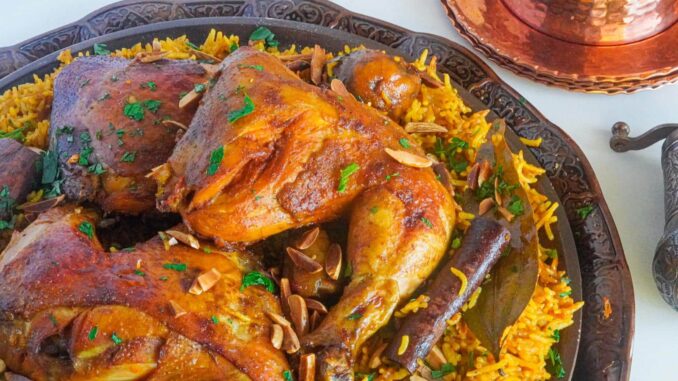
Kabsa, a cherished dish in Saudi Arabian cuisine, is a flavorful and aromatic rice-based dish that reflects the rich culinary heritage of the region. Known for its fragrant spices, tender meat, and vibrant presentation, Kabsa has evolved over centuries to become a symbol of hospitality and communal dining in Saudi culture. In this comprehensive guide, we will embark on a culinary journey to explore the history, ingredients, and recipes of Kabsa, unraveling the secrets behind its tantalizing flavors and cultural significance.
Historical Roots of Kabsa: Tracing the Origins
The origins of Kabsa can be traced back to the Arabian Peninsula, where it emerged as a traditional dish enjoyed by Bedouin tribes and nomadic communities. Over time, Kabsa evolved into a staple meal across the region, influenced by trade routes, cultural exchanges, and the culinary traditions of neighboring countries. The name “Kabsa” itself is derived from the Arabic word “kabs,” meaning to press or squeeze, referring to the technique of cooking rice with flavorful ingredients until it absorbs the aromatic spices and juices of the meat.
Ingredients of Kabsa: A Symphony of Flavors
The key ingredients of Kabsa vary depending on regional preferences and family recipes, but commonly include:
- Rice: Long-grain Basmati rice is the foundation of Kabsa, known for its delicate texture and ability to absorb flavors.
- Meat: Chicken, lamb, or goat meat are often used in Kabsa, providing richness and depth of flavor.
- Spices: A blend of aromatic spices such as cardamom, cinnamon, cloves, bay leaves, and black pepper lends Kabsa its signature flavor profile.
- Tomatoes: Fresh tomatoes or tomato paste add a subtle sweetness and acidity to the dish, enhancing its richness.
- Onions and Garlic: Sautéed onions and garlic contribute savory notes and complexity to the dish.
- Vegetables: Carrots, peas, and potatoes are common additions to Kabsa, providing texture and nutritional balance.
- Nuts and Raisins: Toasted almonds, cashews, or pine nuts, along with plump raisins, add a delightful crunch and sweetness to Kabsa.
Preparation of Kabsa: Crafting the Perfect Dish
The preparation of Kabsa typically involves several steps, including:
- Marinating the Meat: The meat is marinated in a blend of spices, garlic, and yogurt to tenderize and infuse it with flavor.
- Sautéing Aromatics: Onions, garlic, and spices are sautéed in ghee or vegetable oil until fragrant and golden brown.
- Cooking the Meat: The marinated meat is added to the pot and browned on all sides before simmering in a flavorful broth until tender.
- Adding Rice and Vegetables: Once the meat is cooked, the rice, vegetables, and additional spices are added to the pot and simmered until the rice is fluffy and infused with flavor.
- Garnishing and Serving: Kabsa is typically garnished with toasted nuts, raisins, and fresh herbs before being served family-style, accompanied by yogurt, salad, and pickles.
Variations of Kabsa: Regional and Cultural Diversity
Throughout Saudi Arabia and the broader Middle East, Kabsa is prepared in various regional styles, each reflecting local ingredients, traditions, and culinary preferences. Some popular variations of Kabsa include:
- Mandi: A Yemeni-inspired version of Kabsa, where the meat is slow-cooked in a tandoor oven, imparting a smoky flavor to the dish.
- Kabsa Laham: A meat-centric version of Kabsa, where lamb or goat meat is the star ingredient, celebrated for its bold and robust flavors.
- Kabsa Dajaj: A chicken-based version of Kabsa, favored for its tender meat and delicate seasoning, often served during festive occasions and family gatherings.
- Seafood Kabsa: A coastal variation of Kabsa, featuring fresh seafood such as shrimp, fish, or crab, celebrated for its light and aromatic flavors.
Conclusion: Embracing the Timeless Tradition of Kabsa
In conclusion, Kabsa stands as a testament to the culinary ingenuity, cultural diversity, and communal spirit of Saudi Arabian cuisine. With its rich history, vibrant flavors, and versatile preparations, Kabsa continues to captivate the palates and hearts of people around the world, transcending borders and generations. Whether enjoyed as a comforting family meal or served as a centerpiece at celebratory feasts, Kabsa embodies the essence of hospitality, unity, and tradition, inviting us to savor the beauty of shared meals and the richness of cultural exchange.